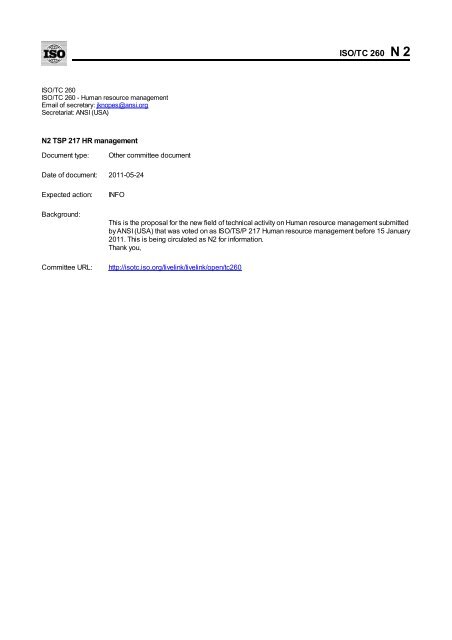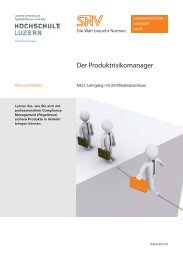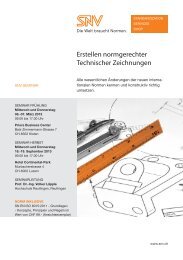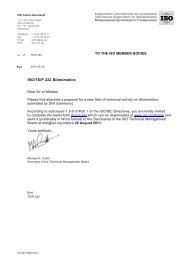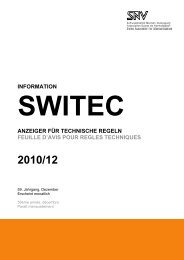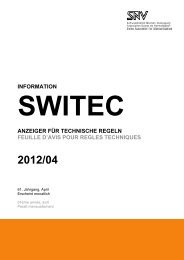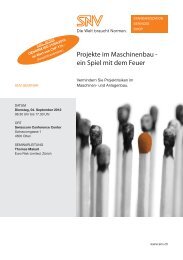ISO/TC 260 N 2 - SNV
ISO/TC 260 N 2 - SNV
ISO/TC 260 N 2 - SNV
- No tags were found...
You also want an ePaper? Increase the reach of your titles
YUMPU automatically turns print PDFs into web optimized ePapers that Google loves.
<strong>ISO</strong>/<strong>TC</strong> <strong>260</strong> N 2<strong>ISO</strong>/<strong>TC</strong> <strong>260</strong><strong>ISO</strong>/<strong>TC</strong> <strong>260</strong> - Human resource managementEmail of secretary: jknopes@ansi.orgSecretariat: ANSI (USA)N2 TSP 217 HR managementDocument type: Other committee documentDate of document: 2011-05-24Expected action:Background:Committee URL:INFOThis is the proposal for the new field of technical activity on Human resource management submittedby ANSI (USA) that was voted on as <strong>ISO</strong>/TS/P 217 Human resource management before 15 January2011. This is being circulated as N2 for information.Thank you,http://isotc.iso.org/livelink/livelink/open/tc<strong>260</strong>
<strong>ISO</strong> Central Secretariat1, ch. de la Voie-CreuseCase postale 56CH - 1211 Genève 20SwitzerlandTelephone + 41 22 749 01 11Fax + 41 22 733 34 30E-mail central@iso.orgWeb www.iso.orgTS/P 217TO THE <strong>ISO</strong> MEMBER BODIES2010-10-15<strong>ISO</strong>/TS/P 217 Human resource managementDear Sir or Madam,Please find attached a proposal for a new field of technical activity on Human resourcemanagement submitted by ANSI (USA).According to subclause 1.5.6 of Part 1 of the <strong>ISO</strong>/IEC Directives, you are kindly invitedto complete the ballot form (Form 02) which can be downloaded at www.iso.org/forms andsend it (preferably in Word format) to the Secretariat of the <strong>ISO</strong> Technical ManagementBoard at tmb@iso.org before 15 January 2011.We wish to inform <strong>ISO</strong> members that comments are expected from the InternationalLabour Organization (ILO) after review of the proposal at the 309 th session of the ILOGoverning Body in November 2010.Yours faithfully,Michael A. SmithSecretary of the Technical Management BoardEncl:TS/P 217STAND TMB/HG/CL
2010-10-13Proposal for new field of <strong>ISO</strong> work (TS/P)Title:Human resource managementDocument Number <strong>ISO</strong> TS/P 217Date of circulation 2010-10-15Closing date of voting 2011-01-15ProposerANSI1. The issue(A simple and concise statement describing the business, technological, societal or environmental issue thatthe proposal seeks to address.)The primary employment interest of organizations is to: identify, hire, and maintain talented workers; fosteran environment that motivates employees to deliver their best efforts in pursuit of organizational objectives;and establish resilient and effective procedures that facilitate these aspirations. According to a 2008 surveyof 4,700 executives conducted by the Boston Consulting Group (“BCG”) and the World Federation ofPersonnel Management Associations (“WFPMA”), global organizations need to master their HR processesand while delivering on recruiting and staffing commitments to meet future challenges. (BCG and WFPMA78)Chart 1The formulation and facilitation of workforce management practices that humanely help employees todeliver on organizational commitments to customers has primarily become a function of the humanresources management professionals or those supervisors who independently perform human resourcemanagement activities. A consequence of the growth and diversity of those who operate Human Resources(“HR”) roles has been their tendency toward fomenting proprietary and complicated solutions tomanagement concerns where simplicity and consistency were warranted. Standardization is seen as aremedy to the bureaucratic inefficiencies that emerge from activities where self-conscious risk aversion canoften overwhelm the flexibility needed in the modern marketplace.While the role and duties of HR professionals has become more complex, the need for effective solutions byindustry leaders has also intensified. During a meeting sponsored by the Society for Human Resource1
Management (“SHRM”), a panel of global HR professionals identified the following needs and concerns thatorganizations have concerning their workforce:Talent management continues to be a high priority and must be more efficient than before whileleveraging cost awareness and monitoring demands for key positions.Finding and retaining quality talent continues to be essential to business sustainability, but is difficultin global markets that may act differently in turns of opportunity and salary treatment.A new approach is needed to develop global workforce cultures, with better understanding oftransnational teams, online collaboration, globalization and business process transformation.Global mobility of high-value workers continues as multinational companies restrict new hires andrelocate talented employees from within their existing workforce. (SHRM 5-6)Global consumers, whether end users or business-to-business, are increasingly basing their purchasedecisions on a vendor‟s treatment of their workers and the general quality of the vendor's work environment.In the United States, there is a strong interest in seeing these worker centered values implemented inpublic policy. “In four polls conducted between 2002 and 2004 by The Program on International PolicyAttitudes (“PIPA”) and the Chicago Council on Global Affairs ("CCFR") 93% of respondents in each surveyagreed that countries that take part in international trade agreements should be „required to maintainminimum standards for working conditions.‟” (World Public Opinion. Org) Customers have also indicatedthat they would be willing to pay more for products from organizations that operate more humanely. “ANovember 1999 study by ICR for Marymount University's Center for Ethical Concerns also found thatAmericans would pay more for non-sweatshop garments. In that poll, 86% said they would be "willing to payup to $1 more for a $20 garment guaranteed to be made in a legitimate shop.‟” (World Public Opinion. Org)Since the HR function oversees the development and implementation of most organizational workforcepractices, organizations will soon need to establish management standards that ensure consistent beneficialwork practices or risk seeing politicians through direct legislation, regulation, or trade agreements respondto these constituent concerns.This international standard would offer broad, coordinating guidance to HR practitioners and harmonizedisparate practices for the benefit of organizations and their employees. This new committee would beresponsible to develop management system standards in the field of HR management, the effect of whichwould be to promote reliable and transferable approaches to workforce management in developed andemerging economies. 1 Moreover, these standards will help organizations adapt to and exploit demographicshifts that influence their access to workers. As indicated in the graph below, in those countries whereemployment participation from the adult workforce has dropped (US and Japan) organizational managerswill need more efficient processes to transfer qualified talent from nations with a higher percentage ofemployable adults (Australia and the Netherlands). Global access to talent is also dependent on theeducational attainment of this workforce as well. According to Professor Paul Sparrow of the ManchesterBusiness School, “between 1995 and 2020 the population of the underdeveloped nations will increase bythe equivalent of the total population of the developed nations.” (Sparrow, Brewster, and Harris 21-22)Meanwhile the latter‟s share of employees educated to the first degree level has dropped from 75% to 40 %of the world population. (Sparrow, Brewster, and Harris 21-22) If trends continue the need to nimbly transferand maintain talent will compel organizations to scale up their workforce practices, particularly in emergingeconomies. Those companies who exploit this opportunity will become more productive than if they focuson traditional growth strategies. 2 The standardization of the exchange of employee competence willbecome as central to the growth of future industries as common rail gauges were to cargo transport, qualityprinciples have been to manufacturing, and information technology harmonization has been to the internetenterprises.1 “These movements of workers will be driven by the growing gap of between the world’s supplies of labor [developingcountries] and the demands for it [from industrialized countries].” (Briscoe 67)2 “A 1995 American report on the relationship between education and productivity at 3,100 U.S. workplaces suggests that a10 percent increase in workforce education leads to, on average, an 8.6 percent gain in productivity. In comparison, a 10percent investment in the traditional capital stock of equipment increase productivity by only 3.4 percent.” (Evans, Pucikand Barsoux 33)2
In a 2010 study commissioned by IBM, based on conversations with more than 700 Chief Human ResourceOfficers worldwide, many organizations were seen to lack the infrastructure to make fact-based decisionsregarding workforce allocation (see Chart 2). “With a lack of insight into what skills and capabilities theorganization has at its disposal at any given time, models that help to evaluate potential talent shortages,and resources that can monitor talent supply and demand, many organizations are placing themselves atrisk for making poor decisions and reacting to market changes after their competition.” (IBM 36) As statedby Christian Archambeau, Principal Director Human Resources, European Patent Office “Knowing whatskills and capability you have in your workforce and employing a common skills taxonomy allows you tomove people around and create flexibility and agility.” (IBM 37) the USA sees global HR standards as anapproach for establishing the infrastructure needed to create this taxonomy.Chart 2The USA recognizes that while different cultures, nations and organizations may have many divergingrequirements and applications for standards, there is a subset of basic practices that are good practices inhuman resource management for most organizations. The USA feels that the value of an <strong>ISO</strong> standard inidentifying those practices, by broad consensus, will serve to increase organizational stability, create aninfrastructure that facilitates talent transfer, and enable metrics by which to set basic guidelines in employeecompetence. While our model is not as clear cut as that of the standard rail gauge described above, whatthe USA proposes is a first for international human resource management and may drive unforeseenpositive changes in the global economy. It is a rational, growth promoting view to assert that organizationscan acquire, develop and apply the skills, knowledge, and other abilities (competencies) of employees mosteffectively in the global marketplace. Moreover, by doing so these firms will have the substantial andenduring competitive advantages.. If they cannot, then the management community must admit thatemployees, much less their cultures, contribute very little value to organizational success. HR helpsorganizations channel human competency to achieve organizational goals. How we do it is “technology” ofHR.3
Chart 3(Department of Labor)Standardization in the field of HR management includes standardization of the certification of practitionersbased upon elements of education, examination, experience and ethical conduct. The standardization ofHR management processes typically includes, but is not limited to, talent acquisition, performancemanagement, training and development, union(works council)/management relations, diversity and inclusionmanagement, gathering workforce data including goals, analyzing and evaluating the organization‟sworkforce plan, developing and presenting employment recommendations and/or alternatives, implementingthe workforce planning recommendations, measuring and monitoring the HR solutions.2. The scope of the issue[Relevant global metrics that demonstrate the extent or magnitude of the economic, technological, societalor environmental issue, or the new market. This may include an estimate of the potential sales of theresulting standard(s) as an indicator of potential usage and global relevance.]Though there are numerous polices and practices regarding the management of organizational workforces,they are often duplicative, inconsistent, and unnecessarily conflicting across national borders. Thedevelopment of unified and generalized approaches to workforce management by a Technical Committeewill define the performance expectations and responsibilities of all professional HR groups that deployhuman capital solutions to achieve their firms‟ organizational goals in industries and sectors throughout theglobe. These management system standards will fill the gap between existing national and transnationallaws and private codes that individual organizations construct. These organizational standards must bespecific, consistent, and measurable. The purpose of these standards is to facilitate efficient and reliableHR operations while avoiding undue restrictions or adverse impacts on the competition for and use ofhuman resources.The standard specifies the minimum effective approaches, measurements and metrics to perform essentialworkforce management practices. It may reduce the barriers to exchange (trade) of talent across regions byharmonizing the processes to physically move talent and the assessments of their competence (skills,knowledge, abilities, and results).4
The standards to be developed within the proposed <strong>TC</strong>, are for minimally effective management practices,derived from consensus, to benefit most organizations most of the time. <strong>ISO</strong> standards should be written ata level to encapsulate those practices that are applicable across cultures. It is expected that each country‟sown national standards could be developed under the <strong>ISO</strong> standard framework and that these nationalstandards could be more reflective of cultural mores and legislative requirements. Individual organizationswould then use the standards they felt relevant to their own needs, as a basis for creating their ownorganizational methodologies. These methodologies would be detailed and based on their core values andspecific needs and would drive their position in the marketplace. Ultimately organizations that wish tomaintain their unique cultures can choose not to follow either national or <strong>ISO</strong> standards. However, if anorganization does choose to follow national or international standards, this decision must reflect theexpectations of the owners (shareholders or members) that the operational leadership follow rationalmanagement approaches that maximize the wealth of the organization, taking due consideration of theeffect of standardization on the culture of the organization.3. Technological benefit(s)(A simple and concise statement describing the technological impact of the proposal to support coherencein systems and emerging technologies, convergence of merging technologies, interoperability, resolution ofcompeting technologies, future innovation, etc.)These organizational standards will permit HR systems from different organizations to transact withoutencountering the data transfer barriers erected among diverse and often impermeable proprietary softwareapplications and information management processes. 3 Talent, information, and processes will migrate andintegrate among organizations in a more flexible and modular manner.4. Economic benefit(s)(A simple and concise statement describing the potential of the proposal to remove barriers to trade,improve international market access, support public procurement, improve business efficiency, result in aflexible, cost-effective means of complying with international and regional rules/conventions, etc.)As the need to exchange and manage talent across borders broadens with the growth of the service sector,organizations and countries are in constant need for workers who have the skill sets and can easily moveamong assignments. Reducing the marketplace barriers that curtail people and information sharing amongorganizations will reduce capital overhead and employee transactional costs. Information and labor can beshared more quickly and with less risk of loss and fewer errors. Moreover labor markets will become truemarketplaces, where commonly understood forms of transaction (employee competencies), complete andtimely information, and virtual/flexible working arrangements will form talent exchanges analogous to stockexchange transactions. Finally, organizational leaders and the greater marketplace would finally have ameans to measure the value of the intangible assets HR organizations and the employees they supportcontribute to their firms.5. Societal benefit(s)(A simple and concise statement describing any societal benefits expected from the proposal.]Societal benefits of the standardization would include the more efficient use of resources through the moreeffective identification and trade of talent across the globe. This would directly reduce the cost of labortransportation and administration and consequently the carbon footprint of workforce practices globally. Amore effective trade of talent increases standards of living, particularly in developed countries, as theneeded and qualified labor are identified and acquired across the globe. We can expect an increase inemployee satisfaction and labor peace as job-to-employee alignment is better achieved through consistentand effective management practices. According to Michael Porter in his book The Competitive Advantage ofNations, a “nation‟s prosperity depends on how efficiently its companies exploited the distinctive strengthswith which it has been endowed.” (Evans 21) As emerging economies provide more of the educated talentdeveloped countries need, their home societies will benefit. Finally, these standards could contribute to the3 There are currently 60 unique HRIS firms in North America alone. This number does not include the many unique subsystemsthat are sold separately. For example: Applicant Tracking Systems (“ATS”). (Comparehris)5
implementation of existing national and regional policies and legislation dealing with worker and humanrights within organizations.The <strong>ISO</strong> Standards developing process affords all members, whether from developed or developingcountries, the opportunity to influence the standard in a manner that serves its own national interests. Sincethese standards are voluntary, affected parties can freely decide to forgo adoption or implementing them.Therefore, organizations from developed countries will not be able to raid developing countries of talentbased on these standards. Note that the opportunities of improved talent transfer can work in bothdirections. Not only could develop countries more easily access talent pools from underdevelopedcountries, but developing countries could improve their workplace practices through these standards makingtheir local firms more attractive places to work for local and cross border talent.6. Environmental benefit(s)(A simple and concise statement describing any environmental or wider sustainability benefits expectedfrom the proposal.)HR tools and processes could interact and interact and emulate those of other organizations. Enhancingthe connections between processes among organizations would allow for more portability of employeesinformation (e.g. performance evaluations, employee benefits, etc.) Besides reducing the need for paperdocuments among organizations, having standardized HR process would promote telecommuting anddistance learning further reducing the carbon footprint created by business travel needs and redundantadministrative workforce practices.7. Intent of the work[A simple and concise statement clearly describing the intended use(s) of the proposed deliverable(s), forexample, whether the deliverable is intended as requirements to support conformity assessment or only asguidance or recommended best practices; whether the deliverable is a management system standard;whether the deliverable is intended for use or reference in technical regulation; whether the deliverable isintended to be used to support legal cases in relation to international treaties and agreements.]The proposed Technical Committee will facilitate the development of a management system of standardsthat codify organizational guidelines, processes, policies, practices, and systems for the HR managementfield associated with all sectors and industries where human labor is applied. Some standards may serveas guidance while others will indicate requirements to support conformity assessment. Standards will servethe profession by providing a baseline for the profession for establishing policies and procedures. Sinceemployment concerns often result in legal disputes, these standards could also serve to support or assistthe profession when implementing international treaties and agreements.There is also a large and growing body of experts eager to get involved in HR standardization. A discussionon global HR standards was held at the Academy of Management meeting in Montreal, Canada in early2010. This is a meeting of several thousand academicians in the area of management from across theglobe. Many of them attended this caucus on HR standards and indicated there will be strong interest fromthe scholarly community to participate once the <strong>ISO</strong> Technical Committee is approved. In late September, apresentation on HR standards was made to the Board and the general attendees of the 2010 WorldCongress of HR Management Associations, also in Montreal. This meeting of global HR associations wassponsored by the World Federation of Personnel Management Associations. Over three thousand HRprofessionals attended. There was strong positive interest in directly participating in the development ofglobal HR standards.8. Metrics(A simple and concise statement of metrics for the committee to track in order to assess the impact of thepublished standard over time to achieve the benefits detailed under the four bullet points immediatelyabove.)These organizational standards may also possess technical or performance requirements (metrics) thatindicate degree to which they meet reliability and efficiency expectations. If a HR organization‟sperformance can be compromised by not having a particular standard or by failing to comply with aparticular standard, then that standard must be measurable. A short list of metrics that could be used to6
determine the use and efficacy of the standard includes: regional/sector cost per hire, regional/sectorturnover, employee satisfaction, regional employment effects, and average Return on Human CapitalInvested (RHCOI). An example of a metric that could be captured in the future in Return on Investment forglobal relocation assignments. According to a recent study by Brookfield Global Relocation Services, only8% of the companies surveyed captured this ROI. (Brookfield Relocation Services 13) The complexity andof gathering and tracking cost data are key reasons why.The impact of the published standards will be measured by <strong>ISO</strong> member participation in the TechnicalCommittee, number of standards sales, number of national adoptions of the <strong>ISO</strong> standards, as well as levelof conformity assessment based upon the standards.9. Beneficiaries(A simple and concise statement identifying and describing affected stakeholders and how they will eachbenefit from the proposal.)The main beneficiaries of the standards include:Public policy leaders: Voluntary consistency of practice will reduce the cost of investigations andother regulatory responsibilities of agencies and ministries charged with overseeing workplacepractices. Organizations: International standardization will facilitate the interchange of talent within andamong international organizations. The cost of managing employees will reduce as workforcemanagement approaches will align with the standards and economies of scale can be applied,across sectors, in relocation, benefits, compensation and other HR functions.Emerging Economies: Talent in developing countries will have increased access to opportunitieselsewhere as the barriers to access are reduced through interoperable workforce staffing practices.Business Leaders: Business leaders and the greater marketplace would finally have a means tomeasure the value of the intangible assets HR organizations and the employees they supportcontribute to their firms. The transparency of practices in countries where businesses operate toprivate codes will enhance their reputations, improve employee morale, lower labor turnover,decrease accidents, enhance product quality and foster greater consumer and investor confidence.(Hepple 71)HR Professionals: The development of organizational HR standards is of major concern for HRprofessionals throughout the world. Section 1 of this Proposal indicates the appetite for standardsamong HR professionals across the globe based on research done by the Boston Consulting Groupand the World Federation of Personnel Management Associations. The “benefits” Sections 3-6 andthe HR Practice Chart in Section A of this Proposal also reveals some of the operational andprofessional benefits that we anticipate will come from global HR standards.Employees: Employees expectations for treatment and opportunity within organizations would bebetter understood by all parties and his or her competencies and other assets would be portable ashe or she transfers among organizations. 4 Whether skilled or unskilled, employees would beincented to improve their capability and to trade them across borders to willing employers.Consumers: The cost of products and services would likely reduce due to an increase in efficiencyof acquisition, transfer, and maintenance of talent. Increased employment and the enhancedintegration of education with business would also be a likely consequence of HR standards.4 One of the challenges in developing international standards will be finding consensus around the different cultural viewsof appropriate workforce practices. For example, recruitment and selection schemes in southern Europe rely heavily onfamily and friends (the cunha in Portugal). They would consider this approach much more cost effective that the definedand dispassionate recruitment and selection practices in the U.S. (Rowley and Warner 61)7
A. The proposer‟s assessment on the prospect of the resulting deliverable(s) being compliant with the <strong>ISO</strong> orIEC Global Relevance Policies and the <strong>ISO</strong> Sustainability Policy where relevant.Global relevance and sustainability interests are met since these standards would ameliorate talentshortages globally by improving the ability of organizations to access talent and for employees to carryboth intangible (competencies) and tangible (financial) benefits with them when changing jobs. Theharmonization and reduction in unnecessary and redundant administrative practices will reducepollution and costs caused by waste. Fundamental differences in HR approaches across the globe thatwill benefit from standardization are:Table 1HR PracticeHR MeasuresHRProfessionalismStaffingPerformanceManagementShared HRServicesEmploymentContractsStandardization/HarmonizationIssueThere are no common measures toevaluate the performance of HRfunctions across sectors or regionsNo common criteria exists fordetermining who is qualified to work inan HR roleUse of selection tests for hires isinconsistent across countries. Forexample US vs. Australia. (Dowling etal. 66)No minimally effective approachesexist for assessing the performance oftalentThe use of systemic HR practices islower in Greek firms compared toforeign subsidiaries, which have moresophisticated practices. (Mendenhall,Oddou and Stahl 50)In Denmark these contracts aretypically oral while in Mexico they arein writing and run for an indefiniteperiod of time. (Briscoe 186 and 192)RemedyStandard HR metrics and measureswould help organizations assess theeffectiveness of their HR operations andacross sectorsStandard code of conduct andcompetencies will improve theperformance of HR professionalsStandard will ease the transfer of talentacross boardersStandard will improve the quality of theassessments and could provide a talentwith information they could use to verifytheir past performance to prospectiveemployers.Standard would improve and legitimizeHR practices in cultures where theseactivities are valued less.Standard could establish the minimumsubject covered and the use of suchagreements, subject to local statues.B. The proposer‟s assessment on compliance with the <strong>ISO</strong>/IEC Policy Principles on the Relationship of <strong>ISO</strong>and IEC Standards to Public Policy and the possible relation of the resulting deliverable(s) to public policy,including a statement regarding the potential for easier market access due to conformity with appropriatelegislation.The effective and harmonious management of labor is a concern of public policy holders throughout theinternational community. Therefore ANSI is committed to ensure that projects comply with the <strong>ISO</strong>/IECPolicy Principles on the Relationship of <strong>ISO</strong> IEC Standards to Public Policy.C. The proposer‟s assessment on how the proposal may be related to, or may appear to be similar to, existingwork in other international or regional organizations (including other <strong>ISO</strong> and IEC committees). Theproposer should explain how the work differs from identified apparently similar work, or explain howduplication will be minimized.International HR management standards would complement the Code of International Labour Law (CILL).The Code is a collection of conventions and recommendations that originate from the Constitution of theInternational Labour Organization (ILO). The Code principally describes the relationship between8
employers and the employed in terms of employees‟ rights and the Conventions direct actions to be takenby the ratifying states and not private employers. Another level of workplace oversight is each privatecompany's codes which are “voluntary written commitments to observe certain standards of conduct ofbusiness.” (Hepple 73) The gap that exists between national and international laws and the random privatecodes comprises the area that this proposed Technical Committee would fill. The <strong>ISO</strong>/<strong>TC</strong> on HumanResources will focus on the standardizing organizational workforce management practices and will avoidsubjects dealing with workers and human rights. Nonetheless, the proposed <strong>TC</strong> may incidentally facilitatethe implementation of ratified codes like the ILO Conventions or cause the consolidation of private codeswithin an industry.In the book International Human Resource Management, Professors Dennis Briscoe and Randall Schulerdefine the consensus of basic employment rights that have been developed by international NGO‟s in thelist below. (Briscoe and Schuler 139) The proposed <strong>TC</strong> would avoid work, as mentioned in the previousparagraph, in these areas:Freedom of Association (i.e., the right to organize and to bargain collectively)Equal employment opportunity and non-discriminationProhibitions against child labor and force (prison or slave) laborBasic principles concerning occupational safety and healthConsultation with workers‟ groups prior to carry out substantial changes such as workforcereductions and plant closuresGrievance or dispute resolution proceduresUse of monitors (internal or external) to audit employment practicesThe proposed <strong>TC</strong> will also reference or seek consistency with any existing and relevant <strong>ISO</strong> standards. Forexample the J<strong>TC</strong> 1/SC 36/WG4 standard for Information Technology for Learning, Education and Trainingthat covers management could be considered in a project concerning training and development standards inorganizations. Meanwhile, elements of the <strong>TC</strong> 69 on the Application of Statistical Methods will likely beuseful in developing HR measures and metrics standards. Furthermore, consistency with other <strong>ISO</strong> MSSstandards and the work of the <strong>ISO</strong>/TMB J<strong>TC</strong>G will be pursued.D. A simple cost/benefit analysis relating the cost of producing the deliverable(s) to the expected economicbenefit to businesses worldwide.In time the economic benefit of organizations following HR standards will exceed the cost of implementingthese measures. The principal economic gain will be the increase in efficiency the organizations will realizeas they all follow staffing, performance management, and training functions that are consistent and relevantacross borders.E. Scope statement the proposed new committee (in the case of a proposal for a new field).Standardization in the field of “Human Resource Management” refers to the [organizational] policies,practices, and systems that influence employee‟s behavior, attitudes, and performances. (Noe et al. 5) TheTechnical Committee seeks to facilitate the development of international standards that codify organizationalguidelines, processes, policies, practices, services, and systems for the HR management field associatedwith all sectors and industries where human labor is applied. The terms “human capital” or “personnel” alsofit within the scope of this committee. The Technical Committee will facilitate Management SystemStandards (“MSS”) development for the following HR content areas:Compensation, Benefits, and Total RewardsEmployee RelationsLegislative and regulatory compliance practicesHR Aspects of Alliances, Joint Ventures, Mergersand AcquisitionsHR Information SystemsPerformance Appraisal and FeedbackChange ManagementWorkforce Planning, Retrenchment, and TalentManagementTraining and DevelopmentJob Analysis and DesignOrganizational DevelopmentTalent Sourcing, Recruiting, and SelectionWorkforce Readiness and SustainabilityLeadership Development9
Diversity and Inclusion Management HR Shared Services, Metrics, Analytics, andBalance Scorecard 5 Wellness and Work/Life Balance ProgramsExpatriate ManagementMeasurementHuman Resource Communications and the HR HR Professional Certification HR Terminology, Nomenclature, and DefinitionsF. The preferred type or types of <strong>ISO</strong> deliverables to be produced under the proposal.The majority of <strong>ISO</strong> deliverables will be international management system standards, though otherdeliverables are possible.G. Proposed initial program of work (in the case of a proposal for a new field).The purpose of the MSS is to provide organizations with an International Standard Specification andGuidance document in the area of Human Resource Management. The HR management standard willaddress the strategic management of workers, to include: talent acquisition, labor supply, employeemanagement systems, and any related redundancy subjects. The standard will also address themeasurement of HR practices, and the implementation of a measurement system to document, assess,report, and validate continuous improvement in the area of HR management. The HR managementSpecification will provide a practical approach to improving the deployment of talent, reducing the costs ofemployees, and improvements in sustainability and that impact both operational efficiently and the carbonfootprint of the organization. Both the technical (functional) aspects of HR management and the strategicmanagement aspects are as indicated in the table below:Table 2ManagerialCrate PolicyEstablish GoalsIdentify TargetsTechnicalMonitor and MeasureDevelop Minimum Effective PracticesConduct HR Audits and AssessmentsManagerial and Technical Leads:Prioritization of HR Continuous Improvement ActionsImplemented HR Improvement ProjectsMeasures and Verified Project ResultsVerified Results Provide Feedback MechanismFor Human Resource Continuous ImprovementThe Guidance Document will provide specific information on meeting the requirements of and implementingthe HR standards.Development of international standards in the following area of Human Resource Management will initiallybe done in the following subgroups:Table 3<strong>TC</strong> XX/CAG<strong>TC</strong> XX/WG 1<strong>TC</strong> XX/WG 2<strong>TC</strong> XX/WG 3<strong>TC</strong> XX/WG 4Chairman Advisory GroupTerminologyCode of Practice for HR ProfessionalsProcessesSystems5 Based on the approach to strategic management was first detailed in a series of articles and books by Drs. Robert Kaplanand David Norton and the French process engineers (who created the Tableau de Bord – literally, a "dashboard" ofperformance measures) in the early part of the 20th century.10
<strong>TC</strong> XX/WG 5Informative guidanceIf the standards that result from this proposed Technical Committee coalesces into a management system, itis not the intent of this proposal that this <strong>ISO</strong> MSS would be used for certification purposes.H. A listing of relevant existing documents at the international, regional and national levels.1. International Labour Organization Conventions and Recommendations (UN/ILO)2. OECD Guidelines for Multinational Enterprises (1976, revised 2000)3. ILO Tripartite Declaration of Principles Concerning Multinational Enterprises and Social Policy(1977)4. Investors in People Body of HR Standards (Penna Plc: UK 2008)5. Hong Kong Institute for HR Management Body of Professional Standards (HKIHRM: HK 2010)6. Human Resource Framework NS HRF-101: 2010 (People Smartz: New Zealand & Australia 2009)7. <strong>ISO</strong> 9001 6.2 Human Resources8. Article V bis GATS: Labour Market Integration Agreements9. Ethical Trading Initiative Base Code (ETI, UK, 1998)10. SA8000®: 2008 (Social Accountability International : New York 2008)11. World Bank Group: International Finance Corporation Performance Standards: Performance Standard 2: Labor and Working Conditions (April 30, 2006) Guidance Note 2: Labor and Working Conditions (July 31, 2007) Good Practice Note on Non-Discrimination and Equal Opportunity (Jan 2006, No. 5) Good Practice Note on Managing Retrenchment (August 2005, No. 4) Workers' Accommodation: Processes and Standards (2009) Labor Toolkit: A Practical Screening and Due Diligence Tool for Project Review (Sept. 2008)NOTE: Most nations and some regions have laws related to labor standards. In some cases, the statutesare interchangeably referred to as standards and codes. This proposed Technical Committee will avoiddeveloping standards where contemporary statutes exist concerning HR and labor management. Forexample: In Africa, “standards” development is actually creating legislation and follows three directions –French and Belgium HR Standards, British HR Standards and Portugal HR standards. Most of theGovernments follow those standards and require foreign private companies to follow the same GovernmentStandards. In Middle East, GCC countries have three standards for their employees both in private or publicsectors – Group I USA, Canada, Europe, Australia, New Zealand and Japan, Group II Asia and Africa, andGroup III Arab Countries. Other Middle Eastern countries develop their HR Standard based on their formercolonial status. In most cases these “standards” tend to be about worker‟s rights rather than managementpractices that improve operational performance. Where a work product exists that is not considered a law,but instead is seen exclusively as consensus based standard or code, this proposed Technical Committeewill avoid that area of work, harmonize its standards project with the existing third-party standard, or adoptthe existing standard as an <strong>ISO</strong> standard.I. A listing of relevant countries to be actively engaged as the subject of the proposal is important to theirnational commercial interests.HRs management is a broad subject and is applicable in all countries, thus ANSI welcomes the participationof any <strong>ISO</strong> member bodies who wish to become actively engaged.11
J. A listing of relevant external international organizations or internal parties (other <strong>ISO</strong> and/or IECcommittees) to be engaged as liaisons in the development of the deliverable(s).United Nations: International Labour OrganizationWorld Federation of Personnel Management AssociationsWorld Bank Group: International Finance CorporationThe World Trade OrganizationFederation of European EmployersThe proposed <strong>TC</strong> would take into consideration prior work by <strong>ISO</strong>/TMB/WG on Social responsibility, <strong>ISO</strong>/<strong>TC</strong>159 on Ergonomics, <strong>TC</strong> 223 on Societal Security, J<strong>TC</strong> 1/SC 36/WG4 Information Technology for Learning,Education and Training, <strong>TC</strong> 236 Project Committee on Project Management, <strong>TC</strong> 69 on the Application ofStatistical Methods, <strong>ISO</strong>/TMB/TF Task Force on Privacy, <strong>ISO</strong>/TMB/PSC Privacy Steering Committee, and<strong>ISO</strong>/<strong>TC</strong> 176 on Quality Management. As such, the HR profession would be better served to have a singularTechnical Committee working within the HR body of knowledge and not create confusion in the marketplaceby placing HR standards work within another viable profession or <strong>TC</strong>. Where appropriate, if there isoverlap, HR standards development would defer to the work done by existing committees. For example,there is content within standards in the <strong>ISO</strong> 9000 family related to HR. The new <strong>TC</strong> would harmonize itsefforts with these existing standards which mostly reflect training and administration. As indicated in thisProposal, the responsibilities of HR professional extend well beyond those categories.K. An expression of commitment from the proposer to provide leadership if the proposal succeeds.If the proposal succeeds, ANSI is committed to providing leadership and will undertake the management ofthe secretariat under the conditional name: “Human Resource Management”.12
Works CitedBoston Consulting Group and the World Federation of Personnel Management Associations. Creating PeopleAdvantage: How to Address HR Challenges Worldwide Through 2015. Boston: BCG and WFPMA,2008Briscoe, Dennis. International Human Resource Management. Englewood Cliffs: Prentice Hall, 1995.Briscoe, Dennis R. and Randal S. Schuler. International Human Resource Management. 2 nd ed. New York:Routledge, 2004.Brookfield Global Relocation Services. Global Relocation Trends 2010 Survey Report. New York: BrookfieldGlobal Relocation Services, LLC, 2010.Comparehris home page. Number of North American HRIS vendors. 21July 2010Dowling, Peter J. et al. International Dimensions of Human Resource Management. 2 nd ed. Belmont, CA:Wadsworth, 1993.Evans, Paul, Vladimir Pucik, and Jean-Louis Barsoux. The Global Challenge: Frameworks for InternationalHuman Resource Management, Boston: McGraw-Hill/Irwin, 2002.Hepple, Bob. Labor Laws and Global Trade. Portland: Hart Publishing, 2005.IBM Global Business Services. Working Beyond Boarders: Insights from the Global Chief Human ResourceOfficer Study. Somers, NY: IBM Corporation, September 2010.Mendenhall, Mark, Gary R. Oddou, and Günter Stahl. Readings and Cases in International Human ResourceManagement. 4 th ed. New York: Routledge, 2007.Noe, Raymond A. et al. Human Resource Management: Gaining a Competitive Advantage. 5 th ed. New York,NY: McGraw-Hill Irwin, 2006.Rowley, Chris and Malcolm Warner, eds. Globalizing International Human Resource Management. New York:Routledge, 2008.SHRM Global Special Expertise Panel. Future Insights: The Top Trends According to SHRM‟s HR SubjectMatter Expert Panels. Alexandria: The Society for Human Resource Management, 2009.Sparrow, Paul, Chris Brewster, and Hilary Harris. Global Human Resource Management. Oxon UK: Routledge,2004.United States. Department of Labor. Bureau of Labor Statistics. Table 2-9, Percent of Employment in Services(in percent). 16 July 2010 World Public Opinion.Org. International Trade: International Labor Standards, 21 July 2010.13


